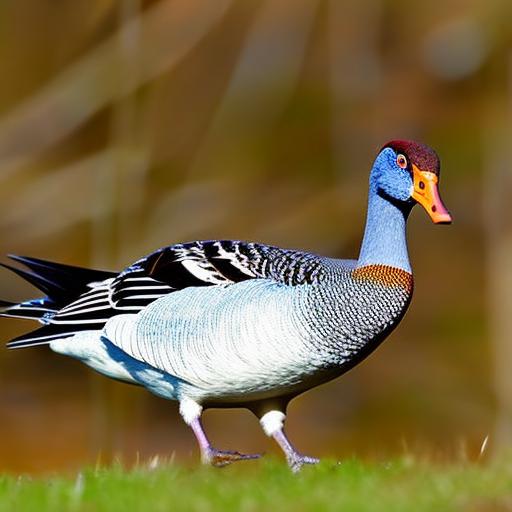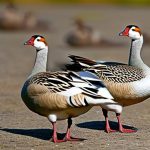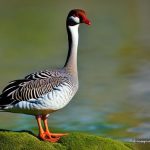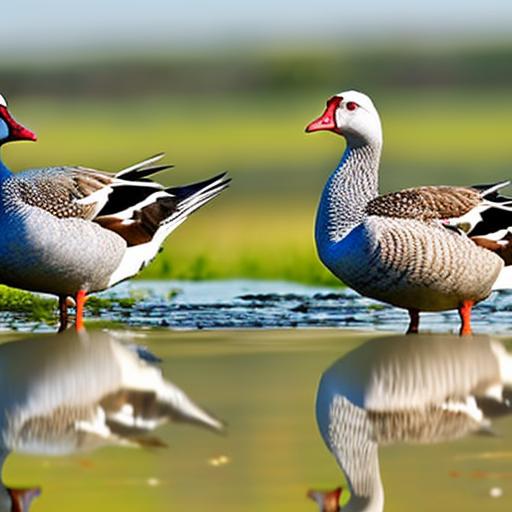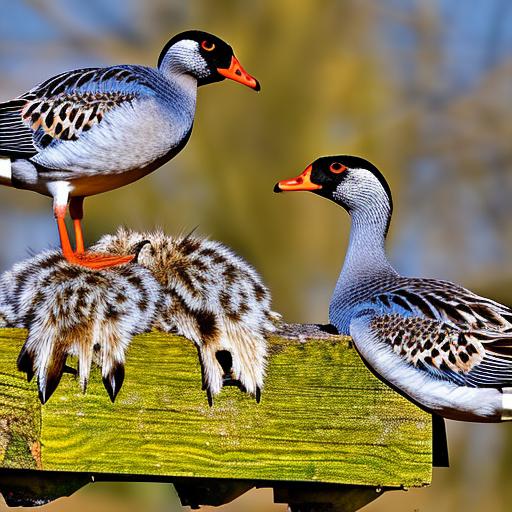Australia is home to a diverse range of geese breeds, each with its own unique characteristics and traits. From the majestic Magpie Goose to the rare and protected Cape Barren Goose, these birds play an important role in the country’s ecosystem and cultural heritage. In this article, we will explore some of the most notable Australian geese breeds, delving into their physical attributes, behaviors, and conservation status.
The Magpie Goose: A Symbol of the Wetlands
The Magpie Goose is a striking and iconic waterfowl that is native to Australia’s wetlands and coastal regions. With its distinctive black and white plumage and long neck, the Magpie Goose is easily recognizable and has become a symbol of the country’s natural beauty. These geese are highly social birds, often gathering in large flocks to forage for food and raise their young. They are also known for their loud honking calls, which can be heard echoing across the wetlands as they communicate with one another. Despite their widespread presence in Australia, the Magpie Goose faces threats from habitat loss and hunting, making conservation efforts crucial to their survival.
The Magpie Goose is a vital part of Australia’s wetland ecosystems, playing a key role in maintaining the balance of these delicate environments. As herbivores, they feed on a variety of aquatic plants, helping to control vegetation growth and create open spaces for other wildlife. Additionally, their nesting habits contribute to the dispersal of seeds and nutrients, further enriching the wetland habitats they inhabit. By protecting the Magpie Goose and its natural habitat, conservationists are not only safeguarding the future of this iconic species but also preserving the health and biodiversity of Australia’s wetlands for generations to come.
The Cape Barren Goose: A Rare and Protected Species
The Cape Barren Goose is a unique and rare waterfowl that is found exclusively in Australia, particularly in the coastal regions of southern Australia and Tasmania. Known for its striking appearance, with a pale grey body, black head, and bright green cere, the Cape Barren Goose is a sight to behold. Despite its beauty, this species has faced significant challenges in recent years, leading to its classification as a protected species under Australian law. Habitat loss, predation, and human disturbance have all contributed to the decline of the Cape Barren Goose population, making conservation efforts essential for its survival.
In addition to its physical beauty, the Cape Barren Goose is also known for its fascinating behaviors and social dynamics. These geese form strong pair bonds and are often seen in small family groups as they forage for food in their coastal habitats. They are also highly vocal birds, using a range of calls and honks to communicate with one another and establish their territory. By raising awareness about the plight of the Cape Barren Goose and implementing targeted conservation measures, we can ensure that this rare and remarkable species continues to thrive in the wild.
The Australian Shelduck: A Stunning and Colorful Waterfowl
The Australian Shelduck is a stunning and colorful waterfowl that is native to Australia’s coastal wetlands and inland waterways. With its vibrant chestnut body, white head, and striking black markings, this species is a true spectacle to behold. The Australian Shelduck is known for its strong pair bonds and monogamous mating habits, with males and females forming lifelong partnerships to raise their young. These geese are also highly adaptable birds, able to thrive in a variety of habitats, from salt marshes to freshwater lakes. However, like many waterfowl species, the Australian Shelduck faces threats from habitat loss and degradation, making conservation efforts crucial for its long-term survival.
In addition to its physical beauty, the Australian Shelduck plays an important role in Australia’s ecosystems as a seed disperser and nutrient recycler. By feeding on a variety of aquatic plants and invertebrates, these geese help to maintain the balance of their habitats, contributing to the health and diversity of these delicate environments. By supporting conservation initiatives that protect the natural habitats of the Australian Shelduck and raise awareness about its importance, we can ensure that this stunning waterfowl continues to grace Australia’s wetlands for generations to come.
The Radjah Shelduck: A Regal and Elegant Goose
The Radjah Shelduck is a regal and elegant waterfowl that is native to Australia’s northern regions, particularly in the wetlands and coastal areas of Queensland and the Northern Territory. With its striking black and white plumage, bright red bill, and regal posture, the Radjah Shelduck is a true symbol of grace and beauty. These geese are highly social birds, often gathering in large flocks to forage for food and raise their young. They are also known for their distinctive honking calls, which can be heard echoing across the wetlands as they communicate with one another. Despite their widespread presence in Australia’s northern regions, the Radjah Shelduck faces threats from habitat loss and hunting, making conservation efforts crucial to their survival.
The Radjah Shelduck is a vital part of Australia’s wetland ecosystems, playing a key role in maintaining the balance of these delicate environments. As herbivores, they feed on a variety of aquatic plants, helping to control vegetation growth and create open spaces for other wildlife. Additionally, their nesting habits contribute to the dispersal of seeds and nutrients, further enriching the wetland habitats they inhabit. By protecting the Radjah Shelduck and its natural habitat, conservationists are not only safeguarding the future of this iconic species but also preserving the health and biodiversity of Australia’s wetlands for generations to come.
The Plumed Whistling Duck: A Vocal and Social Bird
The Plumed Whistling Duck is a vocal and social waterfowl that is native to Australia’s northern regions, particularly in the wetlands and coastal areas of Queensland and the Northern Territory. With its distinctive plumage, long neck, and whistling calls, the Plumed Whistling Duck is easily recognizable and has become a symbol of the country’s natural beauty. These geese are highly social birds, often gathering in large flocks to forage for food and raise their young. They are also known for their loud whistling calls, which can be heard echoing across the wetlands as they communicate with one another. Despite their widespread presence in Australia’s northern regions, the Plumed Whistling Duck faces threats from habitat loss and hunting, making conservation efforts crucial to their survival.
The Plumed Whistling Duck is a vital part of Australia’s wetland ecosystems, playing a key role in maintaining the balance of these delicate environments. As herbivores, they feed on a variety of aquatic plants, helping to control vegetation growth and create open spaces for other wildlife. Additionally, their nesting habits contribute to the dispersal of seeds and nutrients, further enriching the wetland habitats they inhabit. By protecting the Plumed Whistling Duck and its natural habitat, conservationists are not only safeguarding the future of this iconic species but also preserving the health and biodiversity of Australia’s wetlands for generations to come.
The Australian Wood Duck: A Common and Adaptable Waterfowl
The Australian Wood Duck is a common and adaptable waterfowl that is found throughout Australia’s wetlands, rivers, and coastal regions. With its distinctive plumage, long neck, and whistling calls, the Australian Wood Duck is easily recognizable and has become a familiar sight in many parts of the country. These geese are highly adaptable birds, able to thrive in a variety of habitats, from salt marshes to freshwater lakes. They are also known for their strong pair bonds and monogamous mating habits, with males and females forming lifelong partnerships to raise their young. However, like many waterfowl species, the Australian Wood Duck faces threats from habitat loss and degradation, making conservation efforts crucial for its long-term survival.
In addition to its physical beauty, the Australian Wood Duck plays an important role in Australia’s ecosystems as a seed disperser and nutrient recycler. By feeding on a variety of aquatic plants and invertebrates, these geese help to maintain the balance of their habitats, contributing to the health and diversity of these delicate environments. By supporting conservation initiatives that protect the natural habitats of the Australian Wood Duck and raise awareness about its importance, we can ensure that this common waterfowl continues to grace Australia’s wetlands for generations to come.
In conclusion, Australian geese breeds are an integral part of the country’s natural heritage, playing important roles in maintaining ecosystem balance while also serving as symbols of beauty and grace. From the majestic Magpie Goose to the regal Radjah Shelduck, each species has its own unique characteristics that make it worthy of protection and conservation efforts. By raising awareness about these remarkable waterfowl and supporting initiatives that safeguard their natural habitats, we can ensure that Australian geese continue to thrive in the wild for generations to come.
Meet Walter, the feathered-friend fanatic of Florida! Nestled in the sunshine state, Walter struts through life with his feathered companions, clucking his way to happiness. With a coop that’s fancier than a five-star hotel, he’s the Don Juan of the chicken world. When he’s not teaching his hens to do the cha-cha, you’ll find him in a heated debate with his prized rooster, Sir Clucks-a-Lot. Walter’s poultry passion is no yolk; he’s the sunny-side-up guy you never knew you needed in your flock of friends!

